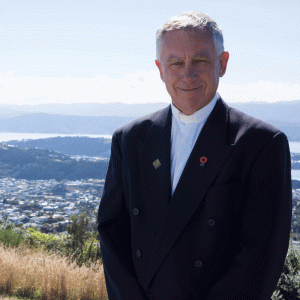WelCom November 2016:
Cardinal John Dew
I consider the opportunity I had recently to be in Canterbury, England, and then in Rome was a great privilege. I was part of IARCCUM – the International Anglican Roman Catholic Commission for Unity and Mission – established in 2000 to attempt to take us a step further on our ecumenical journey. Nineteen Anglican bishops and 19 Catholic bishops gathered from various parts of the world, each of us being ‘twinned’ with a partner bishop from our own country. Bishop Ross Bay, the Anglican bishop of Auckland, and I were the New Zealand representatives.
The whole concept of IARCCUM is for the Anglican and Catholic Churches worldwide to look at where we can be involved in the mission of spreading the Gospel, working together and doing what we are able to do together. ARCIC is another Commission and has been in existence longer than IARCCUM.
ARCIC has made significant progress over the last 50 years examining what each Church’s beliefs are and establishing agreed statements on ‘The Church as Communion’, ‘Authority in the Church’ and such
things as Baptism, Marriage, Mary. However, in this column I do not want to go into the details of what has been done and just what we do agree on, but on some of the very prayerful and powerful moments we shared together in Canterbury and Rome.
Over the days we spent together, first at the magnificent Canterbury Cathedral and then in Rome at various places there were wonderful expressions of the deep unity we are asked to be always working towards. For example, praying Vespers at the Church of St Gregory the Great with Pope Francis and Archbishop Justin Welby was highly significant. This church is the place where Pope Gregory the Great sent Augustine to England in AD 596 to share the Gospel with the Anglo-Saxon people. Therefore, the ‘twinned’ bishops to be sent out from the same part of Rome by the Pope and the Archbishop of Canterbury, was highly significant. These were some of the words we heard and responded to before going to Pope Francis and Archbishop Justin for a blessing and being sent out.
‘As our Lord sent out his disciples in pairs, will you be true pilgrim companions to one another in this missionary Journey? Will you strive to be united in preaching the gospel in word and deed and united in serving those who are most vulnerable and marginalised?
May the ecumenical spirit in which you witness to this gospel be a transformative sign for our communities. May Catholics and Anglicans everywhere be inspired to give a united witness to the world. Like Augustine and his companions gathered under one cross and one Saviour.’
Another wonderful moment was when we gathered at Caravita, a Jesuit church in Rome very near the International Anglican Centre, and which has deep association with the Anglican Centre. These days took place when the Centre, currently headed by New Zealander Archbishop Sir David Moxon, was celebrating its Golden Jubilee.
At the Vespers, celebrated by the Cardinal Secretary of State, Pietro Parolin and the Archbishop of Canterbury, each of the ‘pairs’ of IARCCUM bishops was presented with a Lampedusa Cross. This is a cross made out of wood from the wrecked boats on which so many refugees have lost their lives in the attempt to reach Europe and begin a new life. Pope Francis brought Lampedusa to the world’s attention when he visited that island off the coast of Africa in the Mediterranean Sea in 2013 very
early in his pontificate. It was there he first used the phrase ‘a culture of indifference’ when he challenged the world to realise the many people seeking refuge around the world are our ‘sisters and brothers’ and therefore the world cannot sit back and watch in indifference as lives are lost. The significance in being gifted with this cross was that we had been speaking during our days together of an ‘ecumenism of the cross’. We can come together in support of each other when humiliated by such things as the sexual-abuse crisis; we can speak and reflect on the ‘language of the cross’ together as we strive to work together in the Church’s mission.
One morning, Mass was at the Chair of St Peter with Cardinal Kurt Koch as the chief celebrant. He is the President of the Pontifical Council for the Promotion of Christian Unity. Archbishop Justin Welby, the Anglican primates (archbishops) and the IARCCUM bishops were also present at the Mass. At its conclusion we all processed to the crypt of St Peter’s where Archbishop Welby led Morning Prayer of the Church at the Tomb of St Peter. The following morning we headed to St Paul’s Outside the Walls for Mass. For me, a very significant and moving moment was the ‘pairs’ of bishops processing through the Doors of Mercy two-by-two. For some reason this made a deep impression on me as Bishop Ross Bay and I entered the Church together and were touched by God’s mercy; and again became aware that whether Anglican or Catholic we are ‘missioned’ to be ministers of God’s mercy in our own part of the world.
These IARCCUM days were very rich and I was privileged to be present. The words still ringing in my ears are those of Pope Francis. ‘It would always be good, before beginning a particular activity to ask ourselves the following questions. “Can we not do this together with our Anglican brothers and sisters? Can we not witness to Jesus by working together with our Catholic brothers and sisters?” The pilgrimage that began in Canterbury and Rome calls us forward into a new future TOGETHER, towards a unity that the world may believe.’
